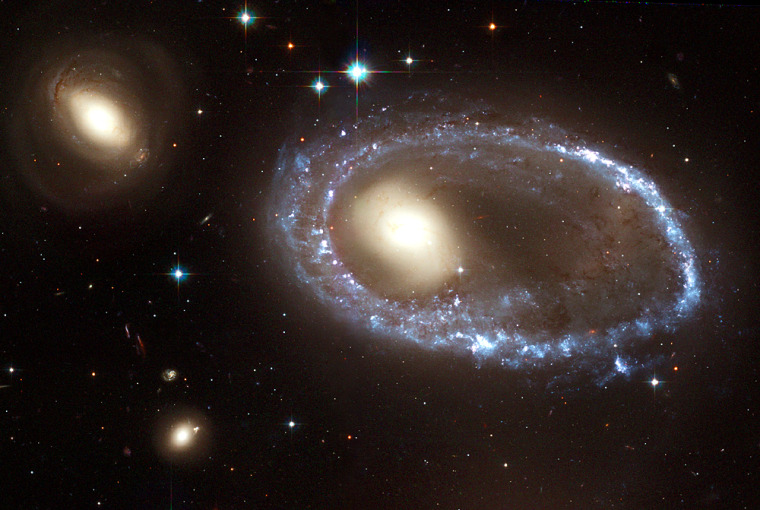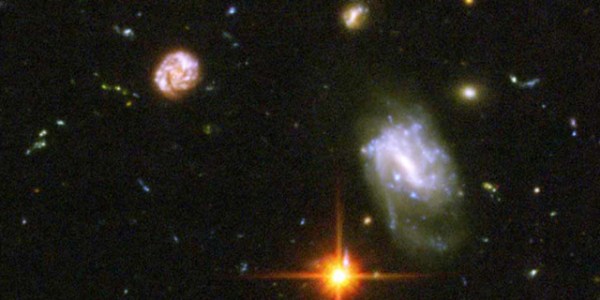During its life in orbit, the Hubble Space Telescope has delivered transporting views of the heavens, pictures that fire the imagination of an unimaginably vast portion of the universe that we can't otherwise see.
To celebrate Hubble's 14th birthday this Saturday, mission managers have given fans and supporters a diamond ring of sorts, a star-studded galaxy in an odd configuration. And as with many Hubble pictures, this one provides plenty of cause for wonder.
The unusual galaxy is made of bright blue star clusters circling a yellowish center. It was long ago victim of a violent collision, which created a sight we earthlings can only try to envision: Anyone living on a planet in the ring would see a brilliant band of blue stars arcing across their night sky, Hubble astronomers said today.
Bad vision
Hubble was lofted into orbit on April 24, 1990. The older George Bush was president and Iraq had not yet invaded Kuwait, triggering the Gulf War.
Hubble didn't work well at first. Its 8-foot (2.4-meter) mirror was less than a hair's width out of shape, and the images were blurry. Astronauts installed corrective glasses in 1993.
The observatory has made 645,000 exposures of more than 20,000 targets while racking up more than 2 billion miles frequent flier miles in its 82,000 orbits around Earth. Hubble's data archive is equal in volume to all the books at the Library of Congress, officials say. Observations in visible, infrared and ultraviolet light from Hubble have generated more than 5,000 scientific papers.
Among its greatest achievements is an ongoing set of observations of supernovas that shows the universe is not just expanding, but doing so at an ever-increasing pace. The blockbuster finding means something called dark energy, which scientists know almost nothing about, is working against gravity -- and winning.
Hubble sees things near and far and in between.
Earlier this year Hubble cranked out the Ultra Deep Field, which contains a zoo of galaxy types and, astronomers expect, the most distant objects ever photographed. The light from the young galaxies traveled for more than 13 billion years to reach Hubble's digital camera.
Somewhat closer to home, Hubble in 2001 made the first direct measurements of the composition of a planet's atmosphere outside our solar system.
Recently the long-lived observatory, now on the chopping block, was used to glean the best possible measurements of the most distant object in our own solar system, a mini-world way beyond Pluto.
Pockmarked with meteoroid impacts, Hubble has over time clocked radically changing winds on Saturn and shown Neptune to have seasons. It spotted mysterious light flashes on Jupiter, and made stunning portraits of Mars.
Hubble's most famous image is of the Eagle Nebula, a popular icon known as the Pillars of Creation. The columns of starlit hydrogen, photographed in 1995 at a distance of 7,000 light-years, have made the covers of religious and philosophy magazines. The image is on anybody's list of Top 10 space photographs.
About that ring
The latest photograph is of a ring galaxy in Southern Hemisphere skies catalogued as AM 0644-741. It is about 300 million light-years away.
The galaxy's unusual shape was created when another galaxy (not visible in the new picture) punched right through its main disk. Gas and stars were forced into an expanding ring -- a bit like what happens when a stone is dropped into a pond. Star birth is rampant. Blue light is from young and hot stars. Pink light is from hydrogen gas that glows in the intense bath of ultraviolet light emitted by all the newborn stars.
The ring is about 150,000 light-years in diameter, larger than our own Milky Way Galaxy. In about 300 million years, the ring will begin to disintegrate, astronomers theorize.
Hubble is a project of cooperation between NASA and the European Space Agency. NASA contracts its daily operation out to the Space Telescope Science Institute, which is run by the Association of Universities for Research in Astronomy, Inc.

